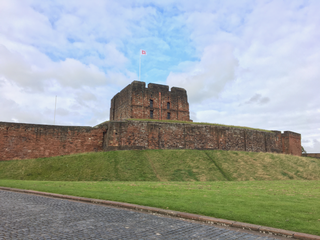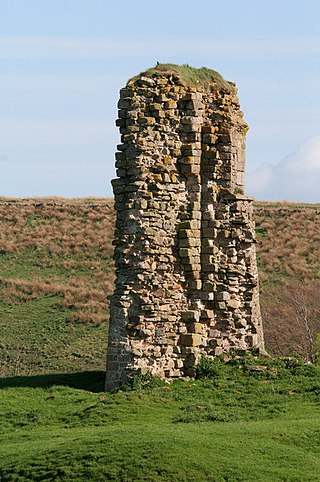
Baron Brougham and Vaux, of Brougham in the County of Westmorland and of High Head Castle in the County of Cumberland, is a title in the Peerage of the United Kingdom. It was created in 1860 for the lawyer, Whig politician and former Lord Chancellor Henry Brougham, 1st Baron Brougham and Vaux, with remainder to his younger brother William Brougham. He had already been created Baron Brougham and Vaux, of Brougham in the County of Westmorland, in 1830, also in the Peerage of the United Kingdom, with normal remainder to the heirs male of his body.

Carlisle Castle is a medieval stone keep fortress located in the city of Carlisle near the ruins of Hadrian's Wall. First built during the reign of William II in 1092 and rebuilt in stone under Henry I in 1122, the castle is over 930 years old and has been the scene of many episodes in British history.


Waberthwaite is a small, former rural civil parish on the south bank of the estuary of the River Esk, in Copeland, Cumbria, England. Since 1934 it has been part of the combined parish of Waberthwaite and Corney, which covers 10 square miles and has a population of 246. It is located opposite Muncaster Castle and the village of Ravenglass which lie on the north bank of the Esk. It is well known for its Cumberland sausages, and lists among its other assets a granite quarry that is a Site of Special Scientific Interest (SSSI); the Esk estuary, which forms part of the Drigg Coast Special Area of Conservation (SAC) - a designation for areas of European importance; the 800-year-old St. John's Church, and the remains of two Anglian/Norse crosses of an earlier period. Archeological finds within 3 kilometres of Waberthwaite indicate that the area has been continuously inhabited since Mesolithic times.
Hugh de Morville of Appleby in Westmorland, England, hereditary Constable of Scotland, was a Norman knight who made his fortune in the service of David FitzMalcolm (d.1153), Prince of the Cumbrians, later King of Scotland.
The Musgrave family was a prominent Anglo-Scottish Border family with many descendants in the United States of America, Australia and the United Kingdom a so-called Riding or Reiver clan of Cumberland and Westmorland. The earliest record of the Musgraves is Gamel, Lord of Musgrave, noted as being "of the county of Westmorland and divers manors in county Cumberland, living in the time of King Edward the Confessor (1042-1065) predating the Norman Conquest." The Musgraves though often Wardens of the West March during the times of the Reivers and among the fourteen most notorious of the reiving clans were known locally as de’ils (devils) dozen and consisted of the following families: Armstrong, Bell, Carleton, Dacre, Elliot, Graham, Johnstone, Kerr, Maxwell, Musgrave, Nixon, Routledge, Scott and Storey.
Ranulf le Meschin, 3rd Earl of Chester (1070−1129) was a Norman magnate based in northern and central England. Originating in Bessin in Normandy, Ranulf made his career in England thanks to his kinship with Hugh d'Avranches - the Earl of Chester, the patronage of kings William II Rufus and Henry I Beauclerc, and his marriage to Lucy, heiress of the Bolingbroke-Spalding estates in Lincolnshire.

Edward Balliol or Edward de Balliol was a claimant to the Scottish throne during the Second War of Scottish Independence. With English help, he ruled parts of the kingdom from 1332 to 1356.
Sir Robert Strickland of Sizergh was an English landowner and politician who sat in the House of Commons in the Parliament of 1624. He supported King Charles I during the Wars of the Three Kingdoms.
William de Lancaster I, or William Fitz Gilbert, was a nobleman of the 12th century in Northwest England during the Anarchy, and the period during which his region was ruled by King David I of Scotland. His position survived the return of English rule under King Henry II, and his most important lordship, which had previously come together under Ivo de Taillebois, would evolve into what was eventually known as the barony of Kendal. According to a document some generations later, he was also referred to as William de Tailboys when younger, and then became "William de Lancaster, baron of Kendal". He died in about 1170.
Sir Richard Lowther of Lowther Hall, Westmorland was an English soldier and official. He was twice High Sheriff of Cumberland and Lord Warden of the West March in 1592.

Sir James Leyburn, also Laybourne, Labourn, etc., was a senior representative of one of the powerful families within the Barony of Kendal. He was at different times a Justice of the Peace for Westmorland, Escheator for Cumberland and Westmorland, and Commissioner for the survey of the monasteries of Lancashire. He was caught up in the troubles at Kendal during the Pilgrimage of Grace (1536-1537). As an assistant to Sir Thomas Wharton, Deputy Warden of the West March, he took an important part in the Battle of Solway Moss (1542). He was one of the two MPs for Westmorland in 1542 and 1545.

John Christian Curwen, born John Christian was an English Member of Parliament and High Sheriff.
Hubert de Vaux, also known as Hubert de Vallibus, was a prominent 12th-century English noble.
Robert de Vaux, also known as Robert de Vallibus,, Baron of Gilsland, was a prominent 12th-century English noble, who served as Sheriff of Cumberland in 1175 and 1176.
Ranulf de Vaux, also known as Randolph or Ranulf de Vallibus, Lord of Triermain and later Lord of Gilsland, was a prominent 12th-century English noble.
Eustace de Vaux, also known as Eustace de Vallibus, Lord of Castle Carrock and Hayton, was a prominent 12th-century English noble.

Triermain Castle was a castle near Brampton, Cumbria, England. Triermain, Cumbria : 'homestead at the stone'

Robert II de Vaux Baron of Gilsland, was an English noble.

Hubert II de Vaux Baron of Gilsland, was an English noble.









